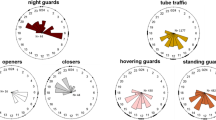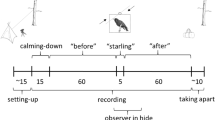Summary
In a nest aggregation of the univoltine sweat beeAgapostemon virescens in New York State, U.S.A., 58% of the adult females switched nests during their adult lives. Continuous guarding protected communal nests against the cleptoparasitic beeNomada articulata which successfully attacked nests occupied by solitary females. All females were egg layers and foraged for pollen at least occasionally. At the end of the foraging season, some nestmates usually acted as guards while others usually foraged.
Resume
Dans un rassemblement de nids de l'HalictinaeAgapostemon virescens, une espèce avec une seule génération par année, dans l'Etat de New York aux Etats-Unis, 58% des femelles ont changé de nid pendant leur vie adulte. Le gardiennage continuel protégeait les nids communaux contre l'abeille cleptoparasiteNomada articulata, qui attaquait avec succès les nids des femelles solitaires. Toutes les femelles jouaient le rôle de pondeuse et de pourvoyeuse de pollen, au moins occasionnellement. A la fin de l'été, quelques-uns des occupants du nid se spécialisent en gardiennes et d'autres en pourvoyeuses.
Similar content being viewed by others
References
Abrams J., Eickwort G.C., 1980.—Biology of the communal sweat beeAgapostemon virescens (Hymenoptera: Halictidæ) in New York State.Search (Cornell Univ. Agr. Exp. Sta.), 1, 20.
Batra S.W.T., 1966.—The life cycle and behavior of the primitively social bee,Lasioglossum zephyrum (Halictidæ).Kans. Univ. Sci. Bull., 46, 359–422.
Brothers D.J., 1972.—Biology and immature stages ofPseudomethoca f. frigida, with notes on other species (Hymenoptera: Mutillidæ).Kans. Univ. Sci. Bull., 50, 1–38.
Claude-Joseph F., 1926.—Recherches biologiques sur les Hyménoptères du Chili (Mellifères).Ann. Sci. nat. (Zool.), 9, 113–268.
Eickwort G.C., 1969.—Tribal positions of Western Hemisphere green sweat bees, with comments on their nest architecture (Hymenoptera: Halictidæ).Ann. ent. Soc. Am., 62, 652–660. 1975.—Gregarious nesting of the mason beeHoplitis anthocopoides and the evolution of parasitism and sociality among megachilid bees.Evolution, Lancaster, Pa., 29, 142–150.
Eickwort G.C., Eickwort K.R., 1969.—Aspects of the biology of Costa Rican halictine bees, I.Agapostemon nasutus (Hymenoptera: Halictidæ).J. Kans. ent. Soc., 42, 421–452.
Knerer G., 1969.—Stones, cement and guards in halictine nest architecture and defense.Ent. News., 80, 141–147.
Knerer G., Schwarz M., 1976.—Halictine social evolution: The Australian enigma.Science, N.Y., 194, 445–448.
Lin N., 1964.—Increased parasitic pressure as a major factor in the evolution of social behavior in halictine bees.Ins. Soc., 11, 187–192.
Lin N., Michener C.D., 1972.—Evolution of sociality in insects.Q. Rev. Biol., 47, 131–159.
Linsley E.G., MacSwain J.W., 1955.—The habits ofNomada opacella Timberlake with notes on other species (Hymenoptera: Anthophoridæ).Wasmann J. Biol., 13, 253–276.
Michener C.D., 1960.—Notes on the biology and supposed parthenogenesis of halictine bees from the Australian region.J. Kans. ent. Soc., 33, 85–96. 1966.—Michener C.D. Interaction among workers from different colonies of sweat bees (Hymenoptera, Halictidœ).Anim. Behav., 14, 126–129. 1974.—Michener C.D. The Social Behavior of the Bees.Harvard University Press, publ., Cambridge, Mass., 404 p.
Michener C.D., Lange R.B., 1958.—Observations on the behavior of Brazilian halictid bees (Hymenoptera, Apoidea) I.Pseudagapostemon. Ann. ent. Soc. Am., 51, 155–164.
Roberts R.B., 1972.—Revision of the bee genusAgapostemon (Hymenoptera: Halictidæ).Kans. Univ. Sci. Bull., 49, 437–590. 1973.—Roberts R.B., Bees of northwestern America:Agapostemon (Hymenoptera: Halictidæ).Ore. St. Univ. Agr. Exp. Sta. Tech. Bull., 125, 1–23.
Sakagami S.F., Hayashida K., 1968.—Bionomics and sociology of the summer matrifilial phase in the social halictine bee,Lasioglossum duplex.J. Fac. Sci. Hokkaido Univ., Ser. VI, Zool., 16, 413–513.
Author information
Authors and Affiliations
Rights and permissions
About this article
Cite this article
Abrams, J., Eickwort, G.C. Nest switching and guarding by the communal sweat beeAgapostemon virescens (Hymenoptera, Halictidae). Ins. Soc 28, 105–116 (1981). https://doi.org/10.1007/BF02223699
Received:
Accepted:
Issue Date:
DOI: https://doi.org/10.1007/BF02223699




